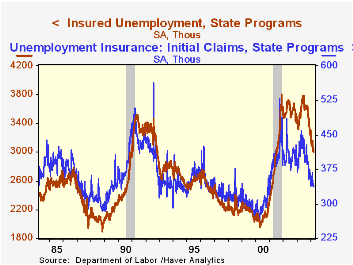 Global| Mar 25 2004
Global| Mar 25 2004Volume Gains & Cost Cutting Lift Q4 Corporate Profits
Summary
The "final" release of U.S. GDP for Q4-2003 showed virtually no revision from the "preliminary" 4.1% growth. Upward revisions to PCE-services and nonresidential structures were offset by downward shifts in inventories and state and [...]

The "final" release of U.S. GDP for Q4-2003 showed virtually no revision from the "preliminary" 4.1% growth. Upward revisions to PCE-services and nonresidential structures were offset by downward shifts in inventories and state and local government outlays.
This report brought the first reading on Q4 corporate profits; these had their third strong quarterly gain in a row, when measured to include inventory valuation and capital consumption adjustments. The resulting "operating profits" were up at quarterly rates of 10.3%, 9.9% and 7.2% in Q2, Q3 and Q4, respectively. Without the accounting adjustments, profits were also strong in Q3 and Q4, but had been soft in Q2, when a tax law change sharply increased depreciation charges calculated for tax purposes.
Whichever way profits are measured, they benefited from both volume gains and cost constraints in the second half of last year. As seen in the table below, value added by domestic non-financial corporations was even stronger than GDP in both Q3 and Q4. Prices increased modestly. But labor costs fell in both periods, and non-labor costs, especially "interest and miscellaneous payments", were down in Q3 and flat in Q4. Unit profits, that is, profit "margins", thus widened significantly. Indeed, at $0.122 per unit value added, operating profit margins were the largest since Q4 of 1997.
| SAAR, % Changes (except as noted) | Q4-2003 | Q3-2003 | 4th Qtr/4th Qtr|||
|---|---|---|---|---|---|
| 2003 | 2002 | 2001 | |||
| Real GDP | 4.1 | 8.2 | 3.1 | 2.2 | 0.5 |
| Real Value Added: Domestic Non-financial Corporations | 5.0 | 9.3 | 5.4 | 3.5 | -1.4 |
| Price per Unit: Dollars | $1.019 | $1.016 | $1.015 | $1.013 | $1.012 |
| % Change | 1.2 | 0.8 | 0.5 | -0.2 | 1.2 |
| Compensation/Unit | -0.6 | -4.2 | -1.8 | -2.8 | 0.4 |
| Non-labor Cost/Unit | 0.0 | -3.2 | -3.6 | 0.0 | 4.1 |
| Profits*/Unit (Qtrly % Chg) | 2.5 | 10.2 | 27.1 | 20.0 | -1.2 |
| Total Profits After Tax** (Qtrly % Chg) | 12.4 | 9.4 | 20.7 | 24.1 | -5.3 |
by Carol Stone March 25, 2004

Initial claims for jobless insurance edged upward last week, interrupting a 3-week- long decline. Even so, the rise was only 1,000 and despite a 2,000 upward revision to the prior week, still allowed the 4-week moving average to decrease to 341,500, its lowest since the end of January 2001.
Continuing claims for unemployment insurance fell 46,000 in the March 13 week from a downwardly revised level in the the prior week, which now shows a 36,000 increase. The latest figure of 3.004 million continuing claims is the lowest since July 27, 2001, i.e., as the economy was experiencing that year's recessionary contraction.
The insured rate of unemployment was unchanged at 2.4% for a fifth consecutive week.
| Unemployment Insurance (000s) | 3/20/04 | 3/13/04 | 3/06/04 | Y/Y | 2003 | 2002 | 2001 |
|---|---|---|---|---|---|---|---|
| Initial Claims | 339 | 338 | 342 | -15.9% | 403 | 404 | 406 |
| Continuing Claims | -- | 3,004 | 3,050 | -13.5% | 3,533 | 3,573 | 3,023 |
Carol Stone, CBE
AuthorMore in Author Profile »Carol Stone, CBE came to Haver Analytics in 2003 following more than 35 years as a financial market economist at major Wall Street financial institutions, most especially Merrill Lynch and Nomura Securities. She had broad experience in analysis and forecasting of flow-of-funds accounts, the federal budget and Federal Reserve operations. At Nomura Securities, among other duties, she developed various indicator forecasting tools and edited a daily global publication produced in London and New York for readers in Tokyo. At Haver Analytics, Carol was a member of the Research Department, aiding database managers with research and documentation efforts, as well as posting commentary on select economic reports. In addition, she conducted Ways-of-the-World, a blog on economic issues for an Episcopal-Church-affiliated website, The Geranium Farm. During her career, Carol served as an officer of the Money Marketeers and the Downtown Economists Club. She had a PhD from NYU's Stern School of Business. She lived in Brooklyn, New York, and had a weekend home on Long Island.





